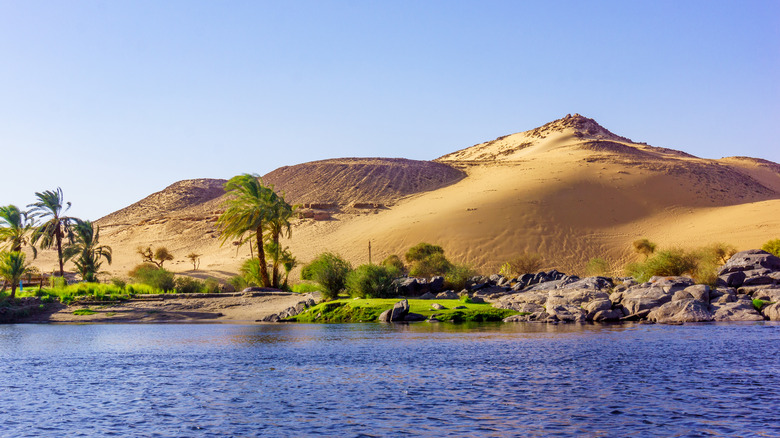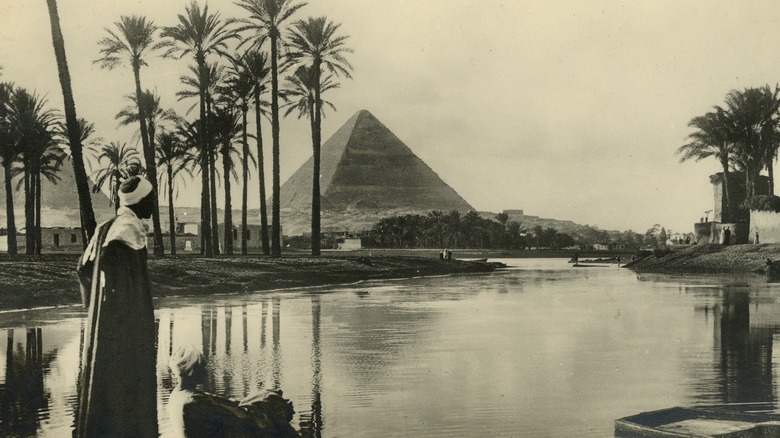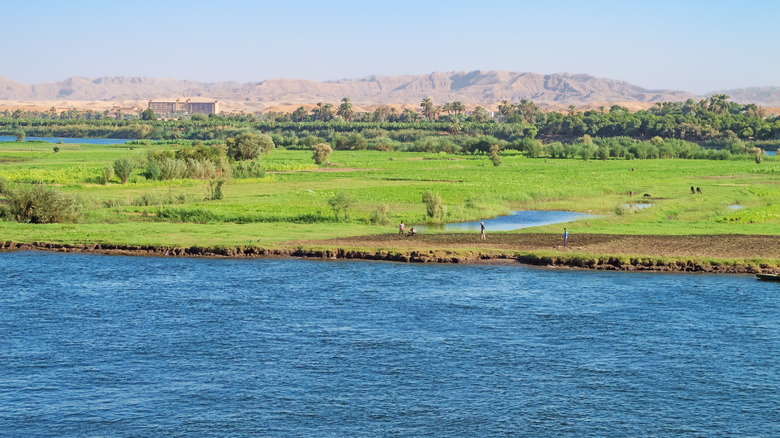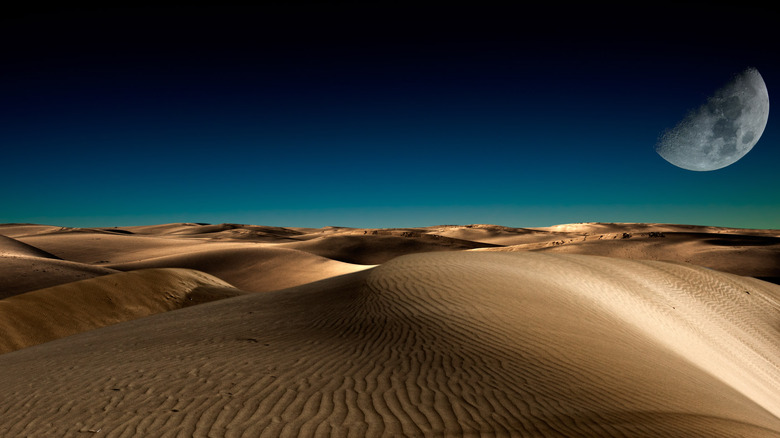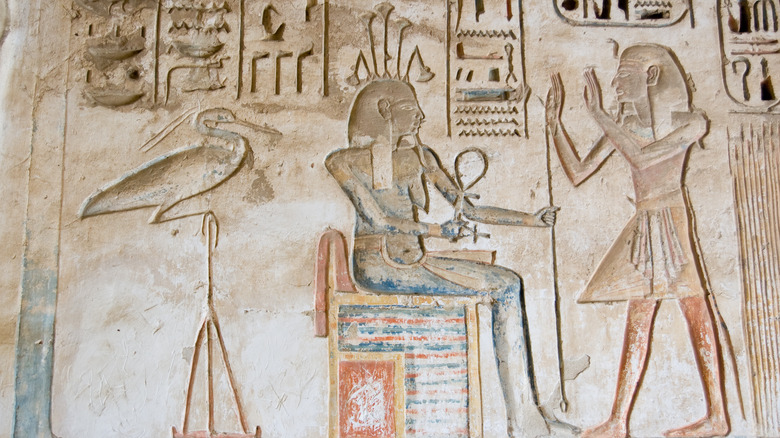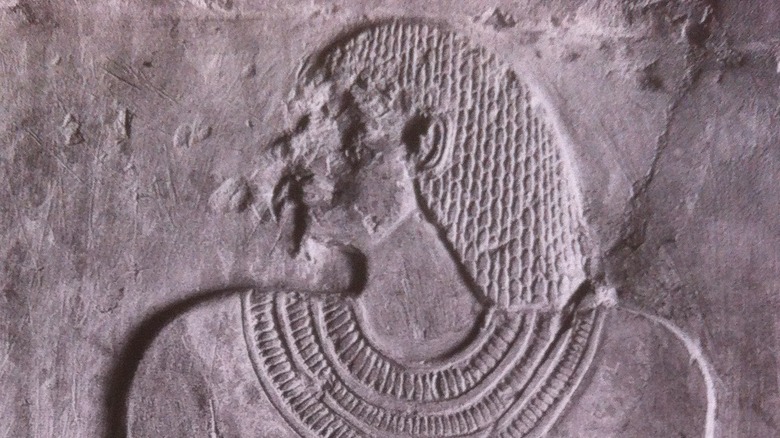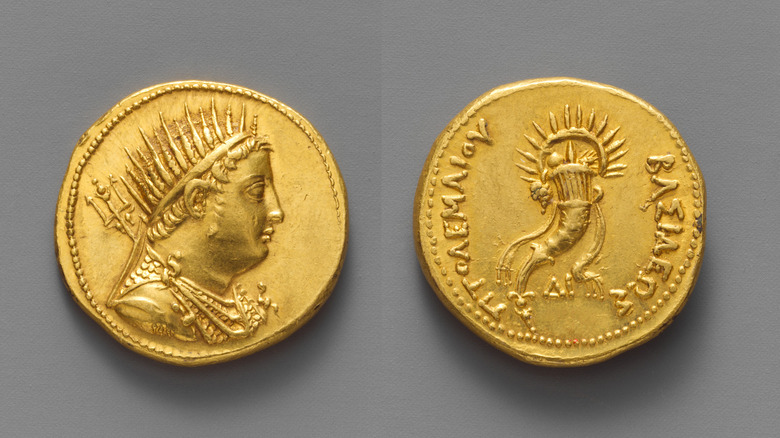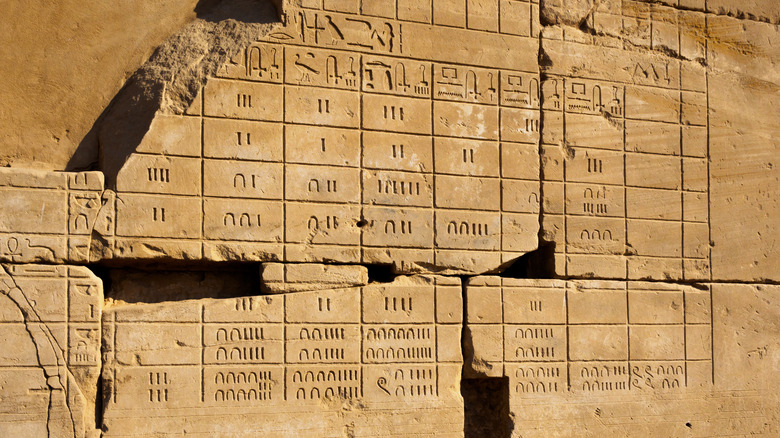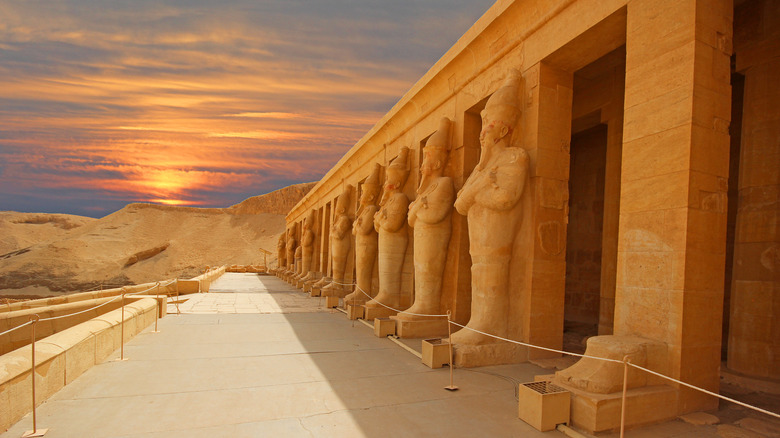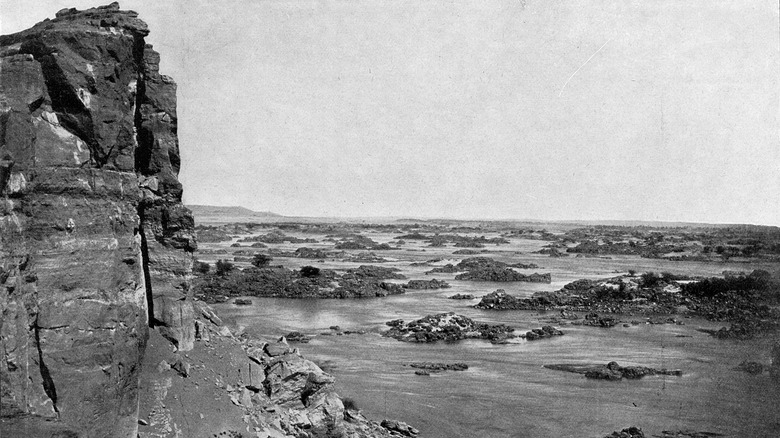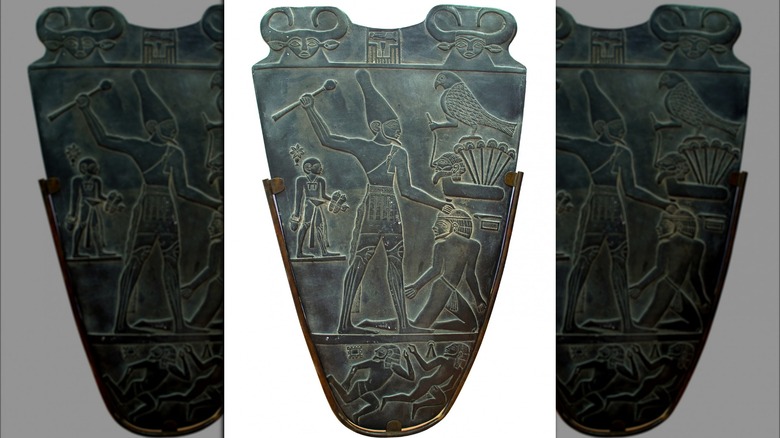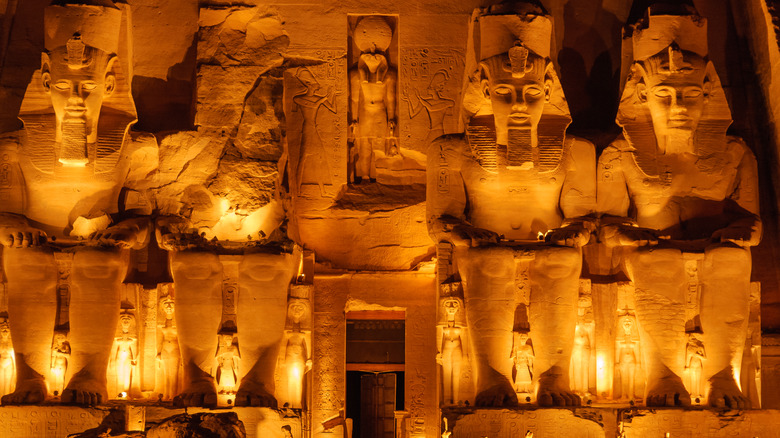Why The Nile Was So Essential In Ancient Egypt
The Nile River, that fertile, green strip of territory surrounded on both sides by inhospitable desert, is inextricably associated with the land of Egypt. Until the 1960s and the construction of the Aswan High Dam, Egypt's destiny was always tied to the Nile flood. The rich, black silt that the river disgorged allowed farmers to survive and thrive on its banks. So fertile was this soil that Egypt at one point was the breadbasket of the entire Eastern Mediterranean.
While the Nile provided Egypt's sustenance, it had economic and spiritual significance, too. The river served as a conduit for trade, united Egypt culturally into a cohesive, relatively homogenous state, and divided the land of the living from the land of the dead. This rich symbolism expressed itself in ancient Egyptian religion and funerary culture, leading to the building of magnificent pyramids, temples, and tombs along the west bank of the Nile. This article shall explore the fascinating story of the river that literally created Egypt — "the black land."
Kmt: the black land
The ancient Egyptians believed in the idea of a cosmic balance between order (Ma'at) and chaos and applied the dualistic idea to many other concepts in their worldview, including their own country. In the ancient Egyptian language, whose descendant Coptic is the liturgical language of the Coptic Church, Egypt was known as Kmt or Kemet. Because the hieroglyphic script did not write short vowels, the exact pronunciation is not known but survives today in Coptic as Kame, which means "black." Hence, the native name for Egypt literally means "the black land." (The word "Egypt" comes from Greek.)
While Afrocentrists have argued that the name of Egypt refers to the skin color of the inhabitants, the Egyptian self-identifier is much better understood in the context of duality. According to the Carnegie Museum, the name Kmt, strictly speaking, referred to the Nile River Valley. On either side of the river, to the East and West, are the Eastern and Western Deserts. The Egyptian knew these as Dsrt or Deshret (hence the English "desert"), "the red land." Hence, the Nile Valley and Egypt were synonymous, highlighting the importance of the river to Egypt's very existence, in contrast to the deserts. That does not mean, however, that the deserts were barren backwaters — they were crucial to Egypt's development as well — but the Nile was Egypt's lifeblood. As Herodotus said, Egypt was "the river's gift."
The lifeblood of Egypt
Why did Herodotus call Egypt a gift from the Nile? To quote a cliché, it is all in the name. The origins of Herodotus' moniker originate in Egypt's literal creation from of the Nile floodwaters, which also gave the country its indigenous name Kmt.
Egypt's existence, down to the geological level, was due to the Nile's annual flood. Every year, per the Canadian Museum of History, rains in the Ethiopian highlands swelled the Nile's water level. The river would disgorge the extra water further north in Egypt on its way to the Mediterranean, flooding the banks of the river. This natural process was critical to Egypt's survival, since most of the population was crowded into the narrow strip of land near the Nile. The floods would dump large amounts of dark, black silt, among the richest, most fertile soil in the world.
This rich, loamy silt provides the origin for the name Kmt. Hence, the very land of Egypt, the "black land," was the annual gift that the Nile gave to Egypt's inhabitants. After the flood, Egypt's farmers took to the fields to plant their crops, which produced enough food to feed the entire Mediterranean region. For this reason, the Nile is known as the lifeblood of Egypt. But it was not always this way. Instead, climatic changes resulted in the expansion of the Sahara that sent humans into the Nile Valley in search of water.
Desertification of the Sahara
Now, the Nile was not always the focal point of Egypt. According to Live Science, around 10,500 years ago, heavy rains turned the Sahara from a desert into a semi-arid savanna that allowed the growth of vegetation and attracted large mammals such as giraffes and elephants. Naturally, it also attracted humans, who spread out from the relatively crowded Nile Valley to take advantage of hunting, pastoral lands, and generally hospitable conditions for human habitation.
Around 6,000 years ago, the Sahara once again gradually reverted to desert. While geologists and climatologists cited in Smithsonian Magazine have noted that the desertification was likely the product of changes in Earth's orbit, domestic animals may have sped the process up. Grazing animals, such as cows, sheep and goats, ate much of the vegetation, allowing the expansion of the desert as the African monsoon weakened.
Once the Sahara became inhospitable desert, the inhabitants were forced to return to the Nile Valley, the only strip of arable, watered land in what otherwise was desert. Although this may have been a tragedy at first, the concentration of people in the region gave rise to the first states in the Nile Valley. Eventually, feuding dynasts would attempt to unite the region into a single state that would become known as Egypt, but it would not become a reality until circa 3000 B.C. under Narmer, the first pharaoh.
The divine inundation
The Nile's importance to Egypt cannot be overstated. But surprisingly, the Egyptians simply referred to the Nile as na-itrw, meaning "the river," the root for the English name Nile via the Greek "Nilos." The Nile itself, contrary to other polytheistic belief systems in places such as Greece, was not considered divine. The Nile inundation, on the other hand, was considered a divine manifestation. The event was personified as a god named Hapy, whose counterpart, Geb, was god of earth (duality again!).
The god Hapy was depicted as a blue-skinned androgynous figure. He had large, feminine breasts, representing fertility, but also a false beard and (presumably) male genitalia covered with a loincloth. He usually carried a jug of pouring water, a symbol of the Nile flood. Every year, priests of Hapy at the southern Egyptian city of Elephantine provided offerings, conducted rituals, and monitored the Nile in hope of a high flood.
Preserved among Egyptian texts is a hymn that testifies to the importance of the flood. Known as "The Hymn to Hapy," it refers to Hapy (the flood) as the bringer of food, the bringer of life, and attests to his role as the guarantor of Egypt's survival. Therefore, as detailed by University College London, it is no surprise that people would cast offerings into the Nile early in the year to pray for the perfect inundation. It was literally a matter of life or death. If Hapy did not "arrive," what would happen? Egyptian history provides evidence for the lethal consequences of multiple failed floods, which could incite rebellions and make or break a pharaoh's reign.
If the flood failed...
One of the Nile's biggest gifts to Egypt was its relative predictability. It flooded more or less around the same time every year, giving Egypt a stable food source. But when floods did fail, it often resulted in unrest, rebellion, and dynastic collapse.
Egypt's history consists of three main periods, the Old, Middle, and New Kingdoms. The end of the former likely coincided with failed Nile floods. This era, called the First Intermediate Period, saw Egypt's pharaohs lose much of their authority to regional governors (nomarchs), resulting in fragmentation and instability.
The autobiography of the vainglorious nomarch Ankhtifi records that in his lifetime, Egypt experienced a severe famine. Allegedly, people resorted to cannibalism of their own children. While these types of inscriptions are often rhetorical, a later Middle Kingdom text called The Prophecy of Neferti preserved the tradition of famine, too. The text lamented that Egypt's river had run dry to the point that one could walk across.
Although these texts exaggerate for literary effect, scientists have found evidence for prolonged drought and failed floods towards the end of the Old Kingdom. Jean-Daniel Stanley et al. concluded that between 2160 and roughly 2000 B.C., Egypt experienced several periods of low or failed floods as a result of changes in the sediment flows and drought. This would have resulted in famine and, predictably, civil unrest and the erosion of central authority, as people turned to their local rulers to provide for them. In such situations, nomarchs like Ankhtifi were happy to step in.
The Great Theban Revolt
According to Penn State, poor Nile floods generally aligned with periods of unrest in Egypt. The Ptolemaic period, nearly 2,000 years after the First Intermediate Period, provides the best records for this correlation. The Ptolemies, Egypt's Greek-speaking Macedonian pharaohs, faced riots and rebellions following several failed Nile floods.
The Canopus Decree of Ptolemy III (ca. 238 B.C.) states that Egypt had been forced to import grain from the Ptolemaic territories throughout the Eastern Mediterranean following a series of failed floods in the 240s B.C. A royal petition (cited in Ludlow and Manning) records that the dry period lasted three years. When it happened again thirty years later, war followed.
By 207 B.C., the Ptolemies had lost their grain-producing overseas possessions critical to Egypt's stability in lean years. That year, a massive, 20-year revolt broke out in Upper Egypt around the old capital of Thebes. Although ethnic and political rivalries, and individual ambitions all exacerbated tensions, a failed Nile flood likely was the immediate spark.
Ludlow and Manning noted that poor floods corresponded neatly with volcanic eruptions that suppressed the Ethiopian monsoons that fed the Nile flood. Major volcanic activity in the years preceding the Canopus Decree and the Theban Revolt is indicated in Iceland and Greenland. Since such activity caused the Nile flood to fail in other eras, Ludlow and Manning propose said failures as yet another cause of the instability. Assuming the correlation-causation link, this event shows just how essential the Nile was to Egypt's stability. Without the flood's gift of rich black silt, there was no Kmt.
The inundation dictated the Egyptian calendar
Because Egypt was literally the product of the Nile flood, all time was tracked according to Nilotic activity. The Egyptian civil calendar is no exception, and although it resembles in part the modern calendar, it was arranged to coincide with different Nilotic occurrences rather than specific weather patterns.
The Egyptian solar calendar resembles today's in that it consists of 365 days. Unlike today's, however, it was divided into three seasons of four months of thirty days each instead of four seasons of three, all based around farming on the Nile floodplain. The first was the season of the inundation (akht), followed by the planting season (prt) and finally, a harvest/low season (smw). The months were named after gods such as Thoth or Hathor, or after festivals. This brings the calendar to 360 days. To make up for the missing days, the Egyptians added an intercalary month of five days.
According to Britannica, although the Egyptian calendar was originally aligned with the elements, there was one major problem. A solar year is approximately 365.25 days. Thus, the Egyptian calendar fell behind the solar year by one day every four years. This threw off the synchronization with the lunar calendar, which was used for determining religious festivals, prompting multiple reforms. Despite its problems, the Coptic Church continues to use the Egyptian calendar for liturgical purposes.
Sailing into eternity
The Nile's primary importance to the Egyptian civilization without a doubt was agriculture, but the river had spiritual significance as well. Egyptians believed in life after death, hence the emphasis on proper preparation of tombs, whether mastabas and pyramids of the Old Kingdom to the rock-cut tombs of the New Kingdom. Notably, most necropoleis in Egypt were built on the West Bank of the Nile. This is because the river marked the boundary between the kingdom of the living and the dead.
According to the Royal Museum of Ontario, Egyptian cosmology associated the East, where the son god was born (i.e. rose), with new life and (re)birth. The West, where the sun god died (set) after crossing the horizon in his solar bark, was associated with death and the afterlife. For this reason, the god of the underworld, Osiris, was known as lord of the West and ruler of the underworld. Upon death, all Egyptian pharaohs had to cross to the West Bank to begin their journeys to the immortal realm.
Part of Egyptian funerary ritual involved crossing the Nile. The body would be loaded onto a boat and taken over the river, symbolically crossing from the land of the living to the land of the dead. The body would then be embalmed and left in its final resting place, whether in a Lower Egyptian Pyramid, Abydos, or the Valley of the Kings. For this reason, Egyptians generally avoided the West Bank of the Nile, to avoid disturbing the spirits resting within the tombs at the desert's edge.
The Nile as a physical border
Not only was the Nile an obvious east-west boundary, but because of its unique geography, it also delineated Egypt's southern boundaries with Nubia. A series of rapids called cataracts created obstacles that were impassable by boat, protecting Egypt's southern frontier and allowing riches from sub-Saharan Africa to enter the land.
Passing the cataracts from Nubia, the territory immediately south of Egypt, was a daunting task. It involved sailing north, but upon hitting a cataract, the boat had to be carried around the rapids. One or two cataracts would have been manageable, but there were a grand total of six. According to Retrospect Journal, however, it created a land corridor between the desert and the Nile that could be easily controlled, leading to the construction of the second cataract forts under Middle Kingdom administrations.
Realizing that the second cataract was the nearest entry point to Egypt from Nubia that could be dominated, Pharaoh Senwosret III ordered the building of several fortresses, the most famous of which are Buhen and Semna. According to Egyptologist Alexander Badawy (via Retrospect), the forts allowed the Egyptians to control the trade of gold, precious and semi-precious stones, livestock, ebony, ivory, and numerous other luxuries that the upper classes stockpiled for their own prestige. As soon as these caravans reached the city of Aswan, where the first cataract was located, the precious cargo was loaded for a boat trip down the Nile. Although the cataracts were an unfortunate topographical feature for sailors, the Egyptians had found a way to turn them to their advantage while using them to protect against Nubian attacks.
The unifying river
The Nile, the deserts, and the seas kept most of Egypt's population into a relatively small area. Hence, Egypt benefitted from the twin boons of protection from foreign invasion and remarkable cultural and political homogeneity.
The Nile served as a communication conduit that united the Two Lands of Upper and Lower Egypt into a cohesive state. Generally, the empires of the Near East had to balance the desire to centralize against the practical realities on the ground. According to the BBC, Egypt was the exception. Because of its cultural unity and compactness, a higher degree of centralization that allowed the pharaohs to control food production, distribution, and taxation of their populace with relatively little resistance was possible. In comparison, highland states like the Hittite Empire of Anatolia were faced with yearly rebellions and decentralized system that depended on the cooperation of their subjects.
The high degree of centralization allowed Egypt's pharaohs to mobilize the labor needed to complete monumental buildings projects such as the pyramids of the Old Kingdom and the impressive mortuary temples of the Middle and New Kingdoms. It has been argued that these projects may have diverted much-needed resources from other sectors of the economy, but one cannot deny the marvels of engineering they built.
The waterway to great kingship
With the Nile providing a link from the African interior to the Mediterranean, Egypt was positioned to become one of the region's superpowers during the Late Bronze Age (ca. 1600-1200 B.C.). During the Late Bronze Age, the Egyptian pharaoh shared the title of great king with fellow rulers in Assyria, Babylon, Syria, and the Hittite Empire. With such a wide network of international contacts, Egypt exported its goods far and wide and imported many more.
According to ASOR, Egyptian colored glass was valued throughout the Eastern Mediterranean. However, it was also valued in Greece and as far north as Scandinavia! Archaeologists in Denmark discovered Egyptian glass beads in Jutland, proving that the links went far further than written evidence suggests. In the opposite direction, the Egyptian ruling class was an avid consumer of amber, the resin-based gem imported from the Baltic Sea, which was brought into Egypt via the Mediterranean. Another exotic they valued was the blue stone lapis lazuli from Afghanistan.
Egyptian trade not only went from the Nile to the Mediterranean but to the Red Sea as well. Using the wadis (dried out river beds), Egyptian ships could reach the Red Sea from the Nile to undertake trade expeditions. Under the "female pharaoh" Hatshepsut, a large training expedition reached Punt (now Eritrea/Somalia). According to Aristotle, Senwosret III may have even attempted to build a canal between the Nile and the Red Sea, a true feat of engineering if successful. Thus, the Nile became Egypt's outlet both to Europe and Asia, making the country rich and its pharaohs meritorious of the title of "great king."
